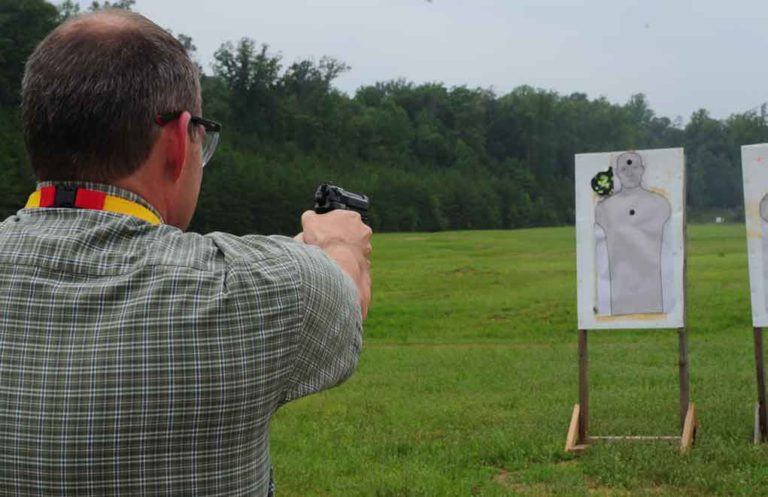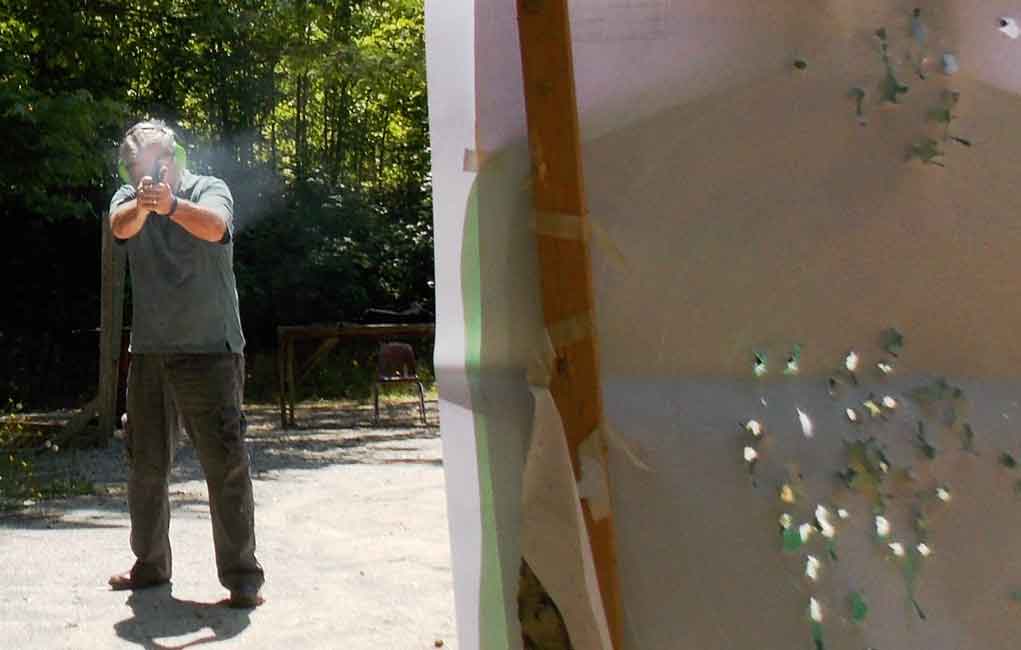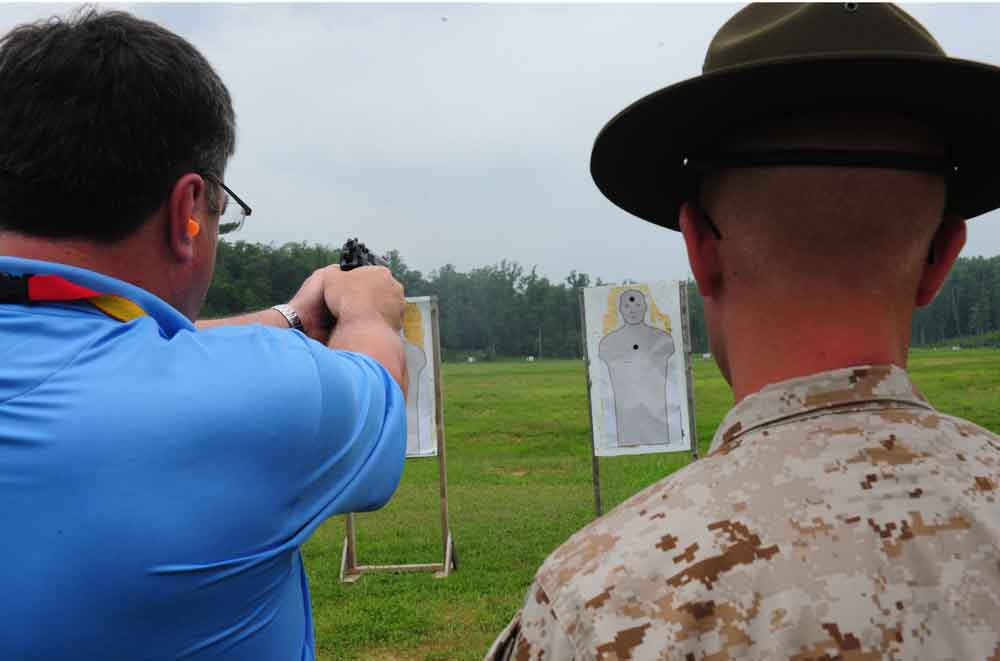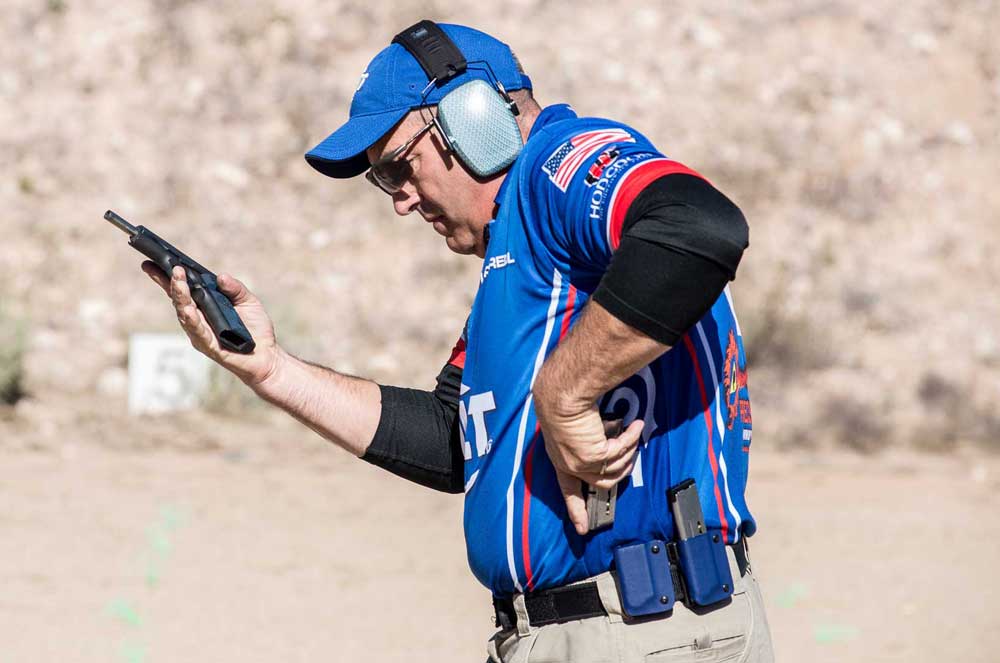
Handgun trainers typically come from a variety of shooting backgrounds. But do these backgrounds necessarily make them the best trainers for armed citizens?
What are the typical backgrounds of most handgun trainers?
- Handgun trainers have three main backgrounds: military, law enforcement, competitive.
- A military trainer must make a successful transition to instructing civilian gun owners.
- LE trainers have experience in dealing with interpersonal violence.
- But, LE trainers also are sworn to confront violent situations when they see them.
- Competitors can teach speed and accuracy, but might miss self-defense nuances.
- Ideal trainers are those who understand the proper application of self defense.
For the purposes of this discussion, our mission will not be military operations nor uniformed police patrol duties. Our task will be to ensure our ability to protect ourselves and our loved ones from death or grievous bodily harm at the hands of an unlawful, predatory criminal attacker. With our end goal well defined, we can look at different training paradigms and see how they fit our needs.

Most firearms trainers in this country will come from one of three backgrounds: military service, police work, or competitive shooting. Some have experience in two of these fields, and a smaller number have experience in all three. This, of course, forms the basis of their curriculum and training methodology.
If they came from the police or military world they usually had entry-level training, such as a police academy or military basic training. They went on to more advanced training, with periodic in-service training. If they worked for an enlightened agency or unit, they were sent to outside schools for more training. If not, the best went to outside schools on their own dime and their own time. Coupled with field experience, this forms the core of their training philosophy. Let’s look at the three major trainer groups separately.
Trainers with a military background

Let’s start with the military paradigm. There are a lot of trainers coming out of the military right now, especially former Special Operations soldiers with a lot of field experience. Unfortunately, a lot of that experience is totally unrelated to domestic, U.S. self defense, both as to circumstance and to operating under U.S. criminal and civil law. I would caution the civilian concealed carrier to take pains to select a military background trainer who has successfully made the transition to training American citizens operating in U.S. cities. Here are some of the key points that make much military-based training inadequate or even improper for the citizen with a carry permit.
First, the soldier is almost always armed with a long gun, with the handgun relegated to the backup-gun role. This very rarely applies to the private citizen, especially away from his home. In your case, the concealed handgun on your person is the only gun you will get to use in self-defense. You can’t go get anything better once the action starts. If you could go, why would you come back?
Next, the military operator works in teams, not alone. He has friends with long guns with him, each with specific duties and areas of responsibility. Not so for the lone defender.
If your plan involves losing one of your children while the rest of the family escapes, I can tell you now, Mom is not going to go for it.
Once contact is made, the soldier can radio for additional support, ranging from more troops to an air strike. You cannot.
There are two factors, however, that really separate the military world from that of an armed citizen. First, the soldier understands and accepts the concept of “acceptable casualties.” In planning any military operation, from platoon level to corps level, you have to figure in casualties from enemy action, equipment failures, and bad luck. You have to start out with enough men to lose some and still accomplish the mission. In our world, the acceptable level of friendly casualties is ZERO. If your plan involves losing one of your children while the rest of the family escapes, I can tell you now, Mom is not going to go for it.
The other issue is that the soldier understands and accepts the concept of “collateral damage.” This includes the injury or death of uninvolved non-combatants. This is inevitable in warfare, and unavoidable. In our world the acceptable percentage of non-involved bystanders killed or injured is ZERO.
Finally, especially in Special Operations, use of firearms is almost always OFFENSIVE in nature, not DEFENSIVE. One ex-mil trainer for whom I have utmost respect has not really been successful at making the transition to civilian training. I recently saw an ad from his school saying in bold letters, “We will make you the aggressor!” The problem is, in U.S. criminal and civil law, “the aggressor” is a synonym for “the defendant.” Remember that your training resume will follow you into court in any criminal or civil action that may arise from your defensive use of deadly force.
Trainers from law enforcement

The next group would be trainers from a purely law enforcement background. They typically have a lot of experience in managing chaos, and usually have a lot of experience investigating violent crimes. Thus, they tend to have a pretty good idea what interpersonal violence involves. This does, not, however, ensure that they have made a good transition to teaching private citizens. Here are some key points to consider.
First, the police officer has a sworn duty to seek out, confront, and arrest very bad people for doing very bad things, and to press forward in the face of armed resistance. This is the opposite of what the citizen should be doing, namely avoidance, deterrence, de-escalation and evasion. Using the firearm is a last ditch, desperate measure, as a last resort for the armed citizen.
Other differences include the fact that the officer will usually have a full size service pistol and lots of spare ammo, body armor, armed and trained partner(s), a long gun in the car, and direct real-time radio contact with armed friends. The armed citizen often has none of these advantages. In fact, even if you could call for help on your cell phone (you won’t be able to until the action is over), the average response time to priority one calls in major American cities is eleven minutes! In eleven minutes, responding officers will have absolutely no impact on the outcome of the fight, they will simply take a report about it.
Also, most police officer-involved shootings in the U.S. involve uniformed patrol officers, who operate in a world vastly different from that of a legitimate private citizen. The circumstances are radically different, which requires radically different training. Contrary to what you see in movies and TV shows, SWAT officers in this country fairly rarely shoot suspects. Their job is to contain the suspect safely and get him out and into custody. SWAT really stands for “Sit, Wait, And Talk.” Detectives also rarely shoot anyone. They mostly shuffle paper and talk to people in a controlled environment. The vast majority of police shootings involve uniformed patrolmen doing a fairly short list of duties.
Most shootings involving uniformed police officers will take place during the conduct of one of three activities: traffic stops, bar enforcement and domestic violence calls. Patrolmen will stop a car for rolling through a stop sign, believing they will be writing a “routine” ticket. They may be unaware that the driver has a kilo of cocaine in the trunk, a stolen pistol on the seat next to him, and a few warrants for his arrest on file. As the officer walks up, he is suddenly confronted with an armed assault. As a private citizen you should not, under any circumstances, be making traffic stops. That eliminates a huge danger area for you.
Police trainers tend to have a distorted view of engagement distances, because of their duty to arrest.
Cops also have to go into seedy dive bars on a regular basis to enforce a laundry list of statutes. They have to look for violations of liquor laws, gambling laws, drug laws, prostitution, parolees, etc. Seedy dive bars are often full of career criminals who are violating their probation or parole, are illegally armed, are holding drugs and so on. The predictable outcome is that cops are often involved in a fight for their lives in these dark, cramped, crowded spaces.
I have done a fair bit of research in this matter, and it appears that over 99% of bar fights occur in bars. Stay the hell out of bars and you will probably never be involved in a bar fight. This eliminates the second major source of police shootings.
The third group involves calls regarding domestic violence complaints. Officers go inside the houses, apartments and trailers of people who are already drunk and enraged. What a shock—they are then involved in a lot of shootings. I do some training periodically for a small rural Sheriff’s Office that only has a dozen deputies. In the last few years they have been involved in three shootings, and all three began as domestic disturbances. You should not be going into other people’s homes and sorting out their marital problems while they are drunk and fighting. That eliminates the third major danger area.
Next issue. Police trainers tend to have a distorted view of engagement distances, because of their duty to arrest. Whether the arrest is for impaired driving or First Degree Murder, at some point in the process the officer has to physically put his hands on the offender. This is the suspect’s last chance to assault the officer and escape, and the moment of physical contact is the most dangerous for the officer. We have tried for decades to find a way to put handcuffs on a suspect by telekinesis, but it just doesn’t work. This is why such a large percentage of police line of duty deaths occur at a distance of 0-5 feet from the assailant. That’s not where the incident began, but it is where it ended.
Competitive shooters as trainers

Then there are trainers with only a competitive shooting background. They may be able to teach you a lot about fast, accurate shooting, and you would be well served to seek out a proven champion shooter in IDPA, USPSA or Steel Challenge shooting to polish up your shooting skills.
Be careful, however, about nuances that may not serve you well in real life self-defense. For instance, we see ready positions in competitive shooting that muzzle everything downrange, all of the time. In many shooting sports, there are penalties for shooting non-threat targets, but not for muzzling them. On the street, muzzling innocents can get you charged with various felonies, from Reckless Endangerment to Aggravated Assault, depending on the jurisdiction. Even if you are acquitted, you lost. Attorneys, bondsmen, and so forth are not free. We see gunhandling that would facilitate getting disarmed in the real world, but not on a shooting range. We also see highly specialized guns and holsters that could not be used on the street.
Lost time measured in scant hundredths of a second mean nothing in a fight.
If you choose to shoot in competition, that’s great. I’ve been involved in small-bore rifle competition in school, PPC competition early in my law enforcement career, and as noted, both IPSC and IDPA matches. You must be careful, however, to mentally separate match shooting and preparation for actual armed conflict.
Finally, the major problem with competitive shooting is a preoccupation with inconsequential increments of time. Lost time measured in scant hundredths of a second mean nothing in a fight, but accumulate and become significant in a match with 10-12 stages. For self-defense, we want the most robust techniques, meaning they work reliably over a broad range of circumstances and under sub-optimal conditions. They may not be the very fastest techniques under optimal match shooting conditions, where you have a clean gun, clean ammo, clean magazines, and are uninjured.
So, in summary, we need trainers who understand the realities of criminal predation against private citizens and understand the criminal and civil legal framework under which we must function.
This article is an excerpt from Straight Talk on Armed Defense.

Next Step: Get your FREE Printable Target Pack
Enhance your shooting precision with our 62 MOA Targets, perfect for rifles and handguns. Crafted in collaboration with Storm Tactical for accuracy and versatility.
Subscribe to the Gun Digest email newsletter and get your downloadable target pack sent straight to your inbox. Stay updated with the latest firearms info in the industry.

![Best Concealed Carry Guns In 2025 [Field Tested] Wilson Combat EDC X9S 1](https://gundigest.com/wp-content/uploads/Wilson-Combat-EDC-X9S-1-324x160.jpg)


![Best 9mm Carbine: Affordable PCCs [Tested] Ruger Carbine Shooting](https://gundigest.com/wp-content/uploads/Ruger-Carbine-Shooting-100x70.jpg)
![Best AR-15: Top Options Available Today [Field Tested] Harrington and Richardson PSA XM177E2 feature](https://gundigest.com/wp-content/uploads/Harrington-and-Richardson-PSA-XM177E2-feature-100x70.jpg)
